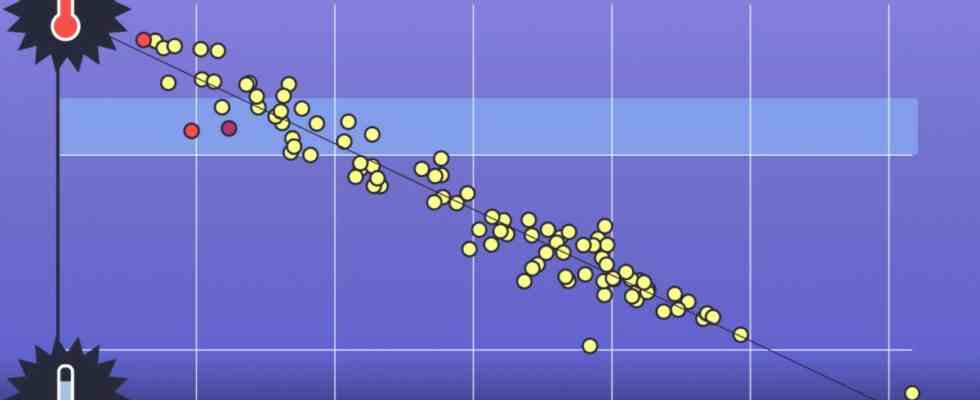The German gas storage facilities are currently well filled – they are at 93 percent. However, for the first time since the nationwide introduction of gas heating in Germany, Russia no longer supplies gas to Germany.
In its situation reports, the Federal Network Agency has been calling for weeks to use gas sparingly in view of the tense situation. In line with this, it has recently published its own data on gas consumption Industry as well as from households and businesses. The latter could only be estimated so far. Now it is based on measurements at so-called coupling points between the long-distance and distribution network.
The gas consumption of households and businesses depends heavily on the heating requirement: In winter, the weekly consumption reported by the Federal Network Agency was ten to 15 times higher than in summer in recent years. After a mild start to the year, consumption was also at a low level in the summer months. In the past two calendar weeks, it has now risen above the long-term average for the years 2018 to 2021.
Does that mean that, despite the warnings and the high price of gas, the Germans have turned on the radiators as if there were no energy crisis? In order to be able to assess this, the consumption must be related to the temperature – the decisive factor for the question of whether people have changed their behavior is not the comparison with the corresponding calendar week of previous years, but with weeks in which it was similar was cool.
The provisional data for the past week (calendar week 39) show lower consumption compared to other weeks with similar temperatures. In the previous week (calendar week 38), gas consumption was even lower at similar temperatures.
There are signs that households are being used more sparingly
It remains to be seen whether this somewhat lower consumption will also continue in winter – or whether it was only achieved because many heaters were not yet switched on. In any case, a look at the second half of the year so far shows that the changed consumer behavior of smaller consumers is reflected in an overall reduction in gas consumption compared to previous years.
Industrial demand has already fallen significantly
the Industry already had significantly lower gas requirements over the summer than in previous years. The required amounts of energy fluctuate less between winter and summer. Consumption usually doubles between summer and winter. It can therefore be assumed that the savings that have been recorded will also continue in winter.
No reduction in gas power generation
Also the gas power generation, which in recent years accounted for about a tenth of all natural gas consumption, is part of industry here. So far, however, no reduction has been observed in gas-fired power generation – which makes it even clearer how large the savings in process energy and in other areas of industrial companies are at the moment.
The reason for the consistently high consumption was, among other things, that gas-fired power plants can be started up quickly and thus compensate for failures of other energy sources at peak times. For example in August, when the failure of numerous nuclear power plants in Europe had to be compensated. The recently high electricity prices are likely to have been a further incentive for the sometimes high level of gas-fired power generation. Gas could be saved here by switching to coal-fired power generation, but this would be associated with greater environmental pollution.
There is another reason why it is not to be expected that gas-fired power generation can be significantly reduced in winter: Many gas-fired power plants generate not only electricity but also heat through cogeneration: This is fed into the district heating network and thus supplies millions of households with heating energy and hot water.
Is Germany saving enough?
How much savings would be necessary now? Scenarios that Science Media Center for Germany, show: Ten percent savings compared to the average consumption from 2018 to 2021 can be enough to survive even a cold winter without supply problems – as long as additional liquid gas terminals go into operation in January as planned and enough deliveries arrive. A saving of twenty percent makes it possible to get by without this additional capacity in an average winter.
However, additional savings would still be better for long-term security of supply – in the first half of the year it was possible to fill the storage facilities relatively quickly with Russian imports. This possibility will no longer be available in the coming year. One Study by the Oxford Institute for Energy Studies comes to the conclusion that the stores could only be filled to a little more than half after the winter, even under optimistic assumptions. In the medium term, rapid expansion of renewable energies is therefore required not only for reasons of climate protection, but also to secure the energy supply. Something that not all political actors have taken to heart in the past.
Methodology:
In order to put the consumption in the context of the temperatures, we use the average mean daily temperature from preliminary data from the German Weather Service from measuring stations in Berlin, Düsseldorf, Frankfurt, Hamburg and Munich. About a third of the population lives in the metropolitan areas around these cities.
The graphics in this article will be updated automatically in the future and can therefore – and because data may be corrected later – differ slightly from the text.

